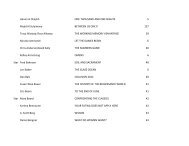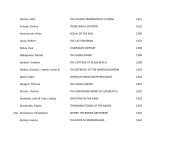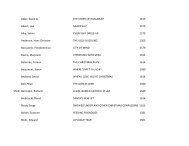nonfiction
nonfiction
nonfiction
Create successful ePaper yourself
Turn your PDF publications into a flip-book with our unique Google optimized e-Paper software.
“…a necessary and accessible<br />
treatment of a common family constellation.”<br />
from living with mom and living with dad<br />
THREE TIMES LUCKY<br />
Turnage, Sheila<br />
Dial (320 pp.)<br />
$16.99 | May 10, 2012<br />
978-0-8037-3670-2<br />
What do you get when you combine<br />
Because of Winn-Dixie’s heart with the<br />
mystery and action of Holes You get an<br />
engaging, spirit-lifting and unforgettable<br />
debut for young readers.<br />
Turnage introduces readers to the<br />
homey yet exotic world of Tupelo Landing, N.C., well-populated<br />
with one-of-a-kind characters. A stranger with justice on<br />
his mind has just arrived in town, and Hurricane Amy is on its<br />
way. Rising sixth-grader Mo LoBeau leads the cast through a<br />
series of clues as the whole town tries to figure out who among<br />
them might be a murderer. The novel’s opening lines reveal the<br />
unflappable Mo LoBeau as a latter-day Philip Marlowe: “Trouble<br />
cruised into Tupelo Landing at exactly seven minutes past<br />
noon on Wednesday, the third of June, flashing a gold badge<br />
and driving a Chevy Impala the color of dirt.” This is the first<br />
of many genius turns of phrases. Pairing the heartbreaking sadness<br />
of children who don’t get their fair share from parents with<br />
the hilarity of small-town life, Turnage achieves a wickedly awesome<br />
tale of an 11-year-old girl with more spirit and gumption<br />
than folks twice her age. Mo LoBeau is destined to become a<br />
standout character in children’s fiction.<br />
Readers may find they never want to leave Tupelo Landing.<br />
(Mystery. 10-14)<br />
A LITTLE BOOK<br />
OF SLIME<br />
Everything That<br />
Oozes, from Killer<br />
Slime to Living Mold<br />
Twist, Clint<br />
Firefly (80 pp.)<br />
$9.95 | May 1, 2012<br />
978-1-77085-006-4<br />
For readers fond of the disgusting, Twist provides a lively<br />
introduction to slime in the natural world.<br />
From pond slime and red tide to phlegm and living snot<br />
mold, the author surveys the slick, sticky substance produced<br />
by living organisms for protection, digestion, defense and more.<br />
In some cases the organism itself is the slime. This disparate<br />
material has been organized into three sections: “Slimy Stuff in<br />
Water,” “Slimy Stuff on Land” and “Other Slimy Stuff.” Short<br />
snappy segments of informal text face full-page, full-bleed<br />
color photographs. Additional photos bring organisms closeup:<br />
a sea cucumber’s feeding tentacles; droplets of cane toad<br />
poison; the spore-bearing slime of the lattice stinkhorn. The<br />
yuck effect is heightened by a design that includes a dripping<br />
blue or green top border, occasional blobs on the page and a<br />
“slime-o-meter” rating. Middle-grade and middle-school readers<br />
may well be acquainted with the slippery surface of a jellyfish<br />
or frog, though they may not have connected that substance<br />
with their own saliva. But colonies of amoebae that creep and<br />
crawl are the stuff of science fiction. The natural world has<br />
plenty of surprises! A helpful glossary defines terms bolded in<br />
the text. There’s an index but no sources or suggestions for further<br />
research for those who want more (and what kid wouldn’t).<br />
Still, this small title has big appeal. (Nonfiction. 9-15)<br />
I SAW A PEACOCK<br />
WITH A FIERY TAIL<br />
Urveti, Ramsingh &<br />
Yamakami, Jonathan<br />
Tara Publishing (56 pp.)<br />
$17.50 | May 15, 2012<br />
978-93-80340-14-2<br />
Creative worlds collude and collide<br />
in this contemporary rendering of a wellknown<br />
17th-century English poem.<br />
Seldom does a book review address a<br />
book’s design, but in this visual stunner<br />
from publisher Tara, the literal setting of the words is as key to<br />
the volume’s success as are its text and illustrations. Urveti, an<br />
acclaimed artist from Madhya Pradesh in central India, chooses<br />
for his subject an oft-anthologized anonymous c.-1665 “trick”<br />
poem, depicting the wily text with ravishingly detailed blackand-white<br />
pen-and-ink drawings in a style typical of Gond<br />
tribal art. The other third of this global collaboration is Brazilian<br />
designer Yamakami’s exquisitely thoughtful setting of the<br />
12-line poem, which highlights the reflexivity of the six couplets.<br />
The meanings of these couplets can be gleaned reading<br />
each line with the rhyme from beginning to end, or—the tricky<br />
part—against it, from the middle of one line to the middle of<br />
the next. Take, for example, the poem’s opening: “I saw a peacock<br />
with a fiery tail / I saw a blazing comet drop down hail / I saw a<br />
cloud….” Through the use of intricate die cuts, Yamakami subtly<br />
leads readers from a spread featuring a plumped-up peacock to<br />
the image of a comet with its “fiery tail” of metaphorical “hail,”<br />
then onto a cloud dropping the more literal icy phenomenon.<br />
These careful cuts draw readers through the work from cover<br />
to cover, brilliantly underscoring both the poem’s dizzying,<br />
dreamlike essence and its thematic obsession with the subjective<br />
nature of seeing.<br />
Indian folk art triumphantly meets 17th-century English<br />
trick verse in this sophisticated graphic venture fit for<br />
middle graders on up. (Picture book/poetry. 10 & up)<br />
COPPERNICKEL<br />
GOES MONDRIAN<br />
van Reek, Wouter<br />
Illus. by van Reek, Wouter<br />
Enchanted Lion Books (40 pp.)<br />
$15.95 | May 14, 2012<br />
978-1-59270-119-3<br />
A red-hoodie–sporting, uprightstanding<br />
bird (or possibly weasel) named<br />
Coppernickel (Coppernickel: The Invention, 2008) and his diminutive<br />
pet dog follow artist Piet Mondrian though a progression<br />
of changes in their setting, time period and bodies.<br />
Quickstep (aka Mondrian), who has a full beak and approximates<br />
an upright-standing bird more than Coppernickel does,<br />
“is looking for the future.” Coppernickel presumes that “If you<br />
just wait, the future will arrive anyway,” but Quickstep disagrees:<br />
“[I]f we stand around waiting, nothing will change…. Things<br />
will only get older. I’m looking for the new.” Quickstep’s dog<br />
can “smell the future” and they’re off. Left-hand trees mimic<br />
Mondrian’s early organic naturalism; as Coppernickel (pursuing<br />
Quickstep) traverses a horizontal landscape scroll, the trees<br />
shift subtly into roadside telegraph poles—or late-Mondrian<br />
grid-style trees. Coppernickel reaches a packed, bustling city.<br />
Gorgeous tiny rectangles tile the subway as Mondrian’s famous<br />
primary colors and grid patterns begin to dominate. Composition<br />
varies dynamically; the scene moves from city blocks<br />
to Mondrian’s spare 1940s apartment. Music emerges from a<br />
turntable in lively primary-colored rectangles, becoming Mondrian’s<br />
famous painting Victory Boogie Woogie, and even the four<br />
characters end up geometrically stylized.<br />
Surreal but fascinating, visually jazzy but conceptually<br />
cryptic, this will work for older readers who like primary<br />
colors, geometric art or the philosophical notion of the<br />
future. (author’s note) (Picture book/art. 7–10)<br />
A TROUBLESOME BOY<br />
Vasey, Paul<br />
Groundwood (232 pp.)<br />
$16.95 | paper $9.95 | $9.95 e-book<br />
May 15, 2012<br />
978-1-55498-154-0<br />
978-1-55498-155-7 paperback<br />
978-1-55498-201-1 e-book<br />
When 14-year-old Teddy is classified<br />
as troublesome, disrespectful and defiant<br />
of authority, his despised stepfather sends him off to St. Ignatius<br />
Academy for Boys, an isolated Roman Catholic boarding school.<br />
St. Iggy’s is run by priests who ruthlessly enforce discipline<br />
through intimidation and abuse. Narrator Teddy befriends the<br />
wisecracking, Wordsworth-loving Cooper. The boys use their<br />
wits and humor to cope, but the endless beatings and humiliations<br />
take their toll, especially on the fragile Cooper. He reaches<br />
his breaking point when he becomes the victim of Father Prince,<br />
a pedophile. Teddy watches helplessly as Cooper withdraws<br />
into his own private nightmare, and Prince targets Teddy himself<br />
as his next victim. The only positive adult relationship the<br />
boys have at school is with the janitor, who takes them to his<br />
farmhouse outside of town on Saturdays to enjoy a brief period<br />
of normalcy. The priests are either bullies or predators; even<br />
Brother Joe, who seems sympathetic to Teddy, betrays his trust.<br />
Although set in a well-realized 1959, Vasey’s brisk, sharply written,<br />
riveting narrative transcends any time period.<br />
A vivid, disturbing and all-too-real topical story. (Historical<br />
fiction. 14 & up)<br />
LIVING WITH MOM<br />
AND LIVING WITH DAD<br />
Walsh, Melanie<br />
Illus. by Walsh, Melanie<br />
Candlewick (40 pp.)<br />
$15.99 | Jun. 1, 2012<br />
978-0-7636-5869-4<br />
Her parents may be divorced, but<br />
this little girl’s family is anything but broken.<br />
Sometimes she lives with her mom, and sometimes with<br />
her dad, and clever lift-the-flap design juxtaposes how things<br />
are in one home versus the other. On her birthday, the girl’s<br />
mother makes a cake, and the flap lifts to show her dad taking<br />
her bowling. Another spread reads, “Sometimes my dad<br />
takes me camping on the weekend…” and the flap lifts to reveal<br />
that sometimes her mom takes her “to see the animals at the<br />
farm.” Other pages show joint activities—both parents attend<br />
a school play, and both are included in a photo album that the<br />
girl can look at if she misses one of them. This last point firmly<br />
situates the family’s co-parenting arrangement on the side of<br />
the child, as does the fact that she freely brings favorite toys<br />
between homes. Despite this laudable content and its charming,<br />
simple, acrylic illustrations, the book lacks careful pacing.<br />
It begins and ends on the endpapers, resulting in a cramped feeling,<br />
and culminates in a rushed ending with pictures of friends<br />
and family who also love the little girl.<br />
Even with this misgiving, this is a necessary and accessible<br />
treatment of a common family constellation. Recommended<br />
for children of divorce and for others seeking to<br />
understand diverse family structures. (Picture book. 2-6)<br />
876 | 15 april 2012 | children’s & teen | kirkusreviews.com |<br />
| kirkusreviews.com | children’s & teen | 15 april 2012 | 877






